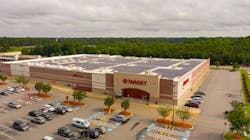Corporate America is doubling down on solar investments, with the nation’s largest companies proving daily that clean energy is good for business. On the one hand, lower electricity costs create an economic advantage that allows companies to reallocate money into more critical areas of business. On the other, companies are achieving aggressive sustainability goals set to reduce their large carbon footprints and subsequent impact on climate change. It’s a win-win. As one study showed, two-thirds of North Americans prefer eco-friendly brands, prioritizing purchases from companies that align with their personal beliefs. Moreover, businesses’ curbed energy expenses help keep operations in the black.
Now, as more companies look to participate in the burgeoning renewable energy field than ever before, understanding the different solar options available will help large commercial and industrial (C&I) businesses begin their foray into the clean energy market.
Offsite Solar
Not surprisingly, the United States’ largest companies are also the largest corporate buyers of renewable energy. Offsite solar farms have given tech giants like Amazon, Google, and Facebook an easy way to bolster their renewable energy portfolios – without the constraints of rooftop or parking lot square footage. For these companies, whose data centers and campus-style offices range in size and location, solar farms can be built on land offsite that accommodates much larger solar arrays and increases the company’s overall production capacity.
- Amazon: Amazon’s investments in offsite solar farms (in combination with onsite solar and wind projects) position the company as the number one renewable energy buyer in the U.S. and Europe. In total, Amazon has purchased more than 7.5 gigawatts (GW) of clean energy.
- Google: Google is the second-largest buyer of renewables, with 6.6 GW of clean energy to its name. In 2019, Google made the biggest corporate purchase of renewable energy in history, one that spanned multiple countries and included 720 megawatts (MW) of solar farm output across the Southern states.
- Facebook: Facebook’s West Texas solar farm was dubbed one of the largest solar projects in the U.S. in 2019, and today the company’s renewable energy portfolio includes 6.1 GW of clean energy. As of 2020, 100 percent of Facebook’s operations were supported by renewable energy and achieving net-zero emissions.
Onsite Solar
While investing in solar farms is an ideal solution for some, there are plenty of big box retailers making a point to install a large portion of solar on their own rooftops, too.
- Target: Reaching its goal set in 2015 to install rooftop solar systems on 500 store locations by 2020, Target took the title for more onsite solar capacity than any other corporation in the U.S., according to Solar Energy Industries Association’s (SEIA) 2019 Solar Means Business report. The company, which installed its first solar array in 2003, now boasts 255.3 MW of installed solar.
- Walmart: Walmart ranks second just behind Target in SEIA’s report. The retail giant boasts 161.2 MW of onsite solar installations, 6.5 MW of which were added to rooftops and parking canopies at California retail locations in 2021 alone. Walmart has been a consistent onsite solar installation leader for years, and in 2020 the company was named the top retailer for annual green power usage by the U.S. Environmental Protection Agency.
- Prologis: Real estate investment trust Prologis installed 133.7 MW of onsite solar, according to SEIA, and has since partnered with Amazon on one of California’s largest rooftop arrays comprising 11,700 solar panels.
Community Solar
Purchasing an entire solar farm may be possible for the Amazons of the world, but the reality is not every business has that luxury. Also, some businesses may lack viable physical space to host energy infrastructure on-site. Fortunately, there is a third alternative: opting into community solar.
In a community solar scenario, businesses can either buy or lease a portion of the solar panels in a nearby solar farm and then receive an electricity bill credit for the energy generated by their share of the solar. Corporations like Daimler Trucks and WorldMark by Wyndham have put their name on community solar projects in Oregon, for example.
In the end, America’s largest corporations have shown that large-scale solar is possible through several avenues and, more importantly, allows them to make critical commitments to both the environment and the communities they serve.
About the Author
EnergyTech Staff
Rod Walton is senior editor for EnergyTech.com. He has spent 17 years covering the energy industry as a newspaper and trade journalist.
Walton formerly was energy writer and business editor at the Tulsa World. Later, he spent six years covering the electricity power sector for Pennwell and Clarion Events. He joined Endeavor and EnergyTech in November 2021.
He can be reached at [email protected].
EnergyTech is focused on the mission critical and large-scale energy users and their sustainability and resiliency goals. These include the commercial and industrial sectors, as well as the military, universities, data centers and microgrids.
Many large-scale energy users such as Fortune 500 companies, and mission-critical users such as military bases, universities, healthcare facilities, public safety and data centers, shifting their energy priorities to reach net-zero carbon goals within the coming decades. These include plans for renewable energy power purchase agreements, but also on-site resiliency projects such as microgrids, combined heat and power, rooftop solar, energy storage, digitalization and building efficiency upgrades.
